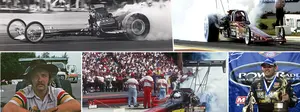

Gary Densham: 49 seasons and counting


No one has driven a nitro Funny Car longer than Gary Densham, who kicked off his 49th season in Pomona. The lifelong Southern Californian is a regional treasure to those who grew up watching him race his line of Teacher’s Pet floppers at tracks up and down the West Coast.
I don’t want to say that no one has done more with less than Densham, but if there’s a line in front of him it’s pretty short. He’s seen it all in his career, from hardscrabble days of chasing the headlights to far-flung match races to unimaginable success during a three-year run as a member of John Force Racing. He’s raced on crumbs and he’s raced on steak and lobster, (but usually the former), but he’s always been Gary Densham. Down to earth, a straight shooter, a hard racer, and a fan favorite.
I spent some time with Densham at the Winternationals for a long-overdue feature that will be appear in the next issue of National Dragster, but my notebook runneth over with stories and photos that wouldn’t fit into the article, so I thought I’d share some of that with you guys here.
HOOKED ON SPEED
“I got hooked on drag racing when I was 13. A friend of mine had an older brother who said there was a track down in Long Beach where the dragsters smoked the tires the whole quarter-mile. I said, ‘[BS], that can’t be done.’ My dad dropped us off in front of Lions at 8 o’clock in the morning; the track wasn’t even open yet, but I remember being in line and helping some guy put together his front-engine dragster, y’know just handing him tools and stuff. But yes, they did smoke them the whole track and went 160 mph. That was it for me.”
A WORKING MAN
Because Densham didn’t come from a well-off family, he built all of his own cars starting with a ‘40 Ford coupe. He yanked out the reliable old flathead, and transplanted a 400-inch Oldsmobile under the hood and had the fastest set of wheels in town.
While his buddies were slinging burgers or pumping gas for $1.25 an hour, Densham instead signed up to load trucks for a living, a job that paid $3.90 an hour. He was still in school, so he could make more money than his pals in half the time and still have time for school and hot rods. But it wasn’t an easy gig.
“The guy that ran it was an old Marine drill sergeant and worked us to death,” Densham recalled. “He had a six-word vocabulary and five of them were cuss words. It was a hell hole. We would hire 10 new guys a night and we’d be lucky if one came back the next day. We had guys puking off the edge of the dock. But it paid good.”
GARY DENSHAM, OLYMPIAN?

It could have happened. Densham played football at Bellflower High but he also was a star wrestler, all-city, all conference. He wasn’t the biggest guy but he was quick and smart.
“We talk about everything we’ve accomplished in drag racing because we love it, and I wouldn’t change a thing about it," he mused, "but when I look back there was only one thing that I wonder about.
“Wrestling in college, there was a guy in our league who was really good, and I beat him twice. But when it came time to go to the tournament, it was the same weekend as Bakersfield [the March Meet]. I said, ‘Coach, I love you dearly, but I want to go racing.’ Long story short, at the end of the year that guy qualified to go to the Olympics. I think, ‘Could that have been me?' Maybe. That might be the only big regret in my life."
I'D RATHER BE BLOWN
Living in a one-bedroom bachelor apartment left Densham nowhere to work on his cars, so he rented a unit in a row of commercial buildings. It was a fortunate move, considering who his neighbors were, but far from glamorous.

“We called them the caves,” he recalled. “They were 800 square feet; just four bare walls, a toilet, and one light bulb. But during that era, Steve Plueger was there; Steve Leach of RCD was there; Chuck Finders, who built all of those A/Gas Supercharged cars, was there; Ray Zeller was there. More than half of them were into racing.
“This was right in the heyday of the A/Gas Supercharged cars. We knew the were faster, but they were heavier and had the same size motor we did. The answer was simple: That pretty thing sitting on top of the motor: the supercharger.
“The first car I ever put a blower on was my chopped-top ’33 Willys. It was at Long Beach [Lion’s], in the fog, racing Willie Borsch. I stood on the gas and it just scared the crap out of me. I was so scared I went from 1st gear to 4th and when I got out at the other end my legs were shaking so hard I could barely stand up. But it was magic.”
TASTING SUCCESS .... AND NITRO
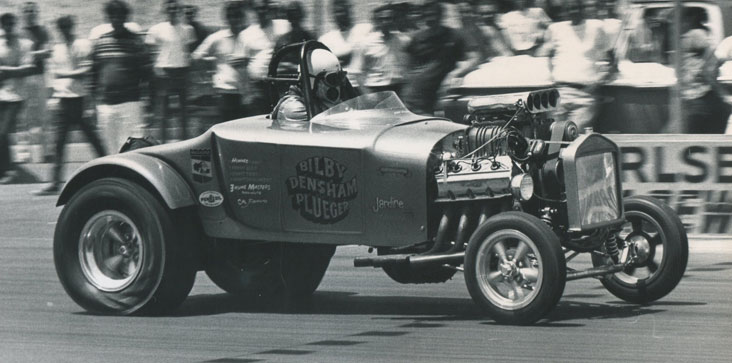
Although Densham had a lot of cars before that first flopper in 1971, he built a succession of progressively faster cars, leading up to a national record-setting T roadster that he campaigned with Plueger and young Lee Bilby, a kid who didn’t fit into any of the jock/geek/hot rodder/surfer cliques but had a thick wallet. The car was super successful, but the itch to go faster had to be scratched.
“Plueger had run a Top Fuel dragster before so he knew a little about nitro and convinced me to put nitro in the car,” Densham remembers. “It was only 10 percent. I hit the gas and couldn’t believe you could get magic in a can. I was hooked.”
FUNNY BUSINESS

“The first time we saw Funny Cars, we all saw the handwriting on the wall and my roadster went up for sale,” he remembers. “Top Fuel dragsters were faster, but the Funny Cars looked like cars that people could identify with. Fans could jump and down and root for a Chevy or a Ford or a Dodge.”
Densham’s first car was this Pinto, but it was just the first of many. (Auto Imagery photo)
TEACHER'S PET

This Dodge Challenger was the first car to wear the Teacher’s Pet moniker. Densham began teaching auto shop in 1969 at El Rancho High School in Pico Rivera and moved to Gahr High, where he would spend 27 years teaching kids how to work on cars, so the name was a natural.
“That Challenger was, proportionately, the nicest car I ever owned,” he recalled with pride. “I built everything myself. At the time there were still some steel-bodied cars with those wide Logghe chassis, but this was narrow-rollcage car. All of the tin was polished, and everything was anodized and chromed.”
THE DATSUN

When NHRA legalized the use of foreign-car bodies for Funny Car competition, Datsun –- which was, oddly, enough, NHRA’s “official car” at the time -– was the first to take advantage, and Densham was in on the ground floor.
“Kenny Cox was building bodies back then and I made a deal with Datsun to build the body for them. I had a friend who worked at a Datsun dealership, I borrowed a car off the showroom floor, brought it home for the weekend, and made the mold. I thought I was so clever, masking it off with duct tape, but the chemicals had a reaction to the glue in the tape and it ruined that paint job; the car was striped like a zebra. I had to repaint it. I stayed up 36 straight hours to do it so I could get it back to the dealer.
"I should have gotten the first body but John Collins had Pioneer [stereo as a sponsor], and Pioneer was already in bed with Datsun through Paul Newman’s [sports car team]. I told Datsun I would supply John with a body if they would give me some money, but for whatever reason Cox gave the first body to Collins. I was pretty pissed.”
Densham’s Datsun eventually burned to the ground in a nasty fire at the 1981 World Finals.
FINALLY GOT ONE ...

Densham built his own cars for years, copying the work of longtime buddy Steve Plueger because he could never afford to own a genuine Plueger car until he bought this car in 1982 from Johnny Loper.
GIVE 'EM WHAT THEY WANT ...
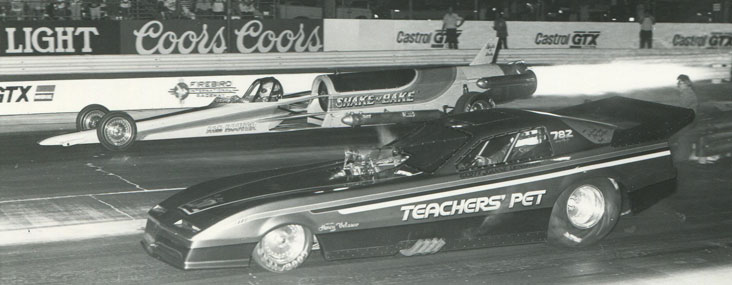
“We made all of our money match races and then spent it all to run the national events. We’d run jets, Top Fuelers, whatever the promoter wanted. If you ran the car sensibly and put on a good show, you got paid to do it. You showed up on time, did what the promoter asked, and ran good, and you could make enough money to run the car.”
HOW I MET JOHN FORCE
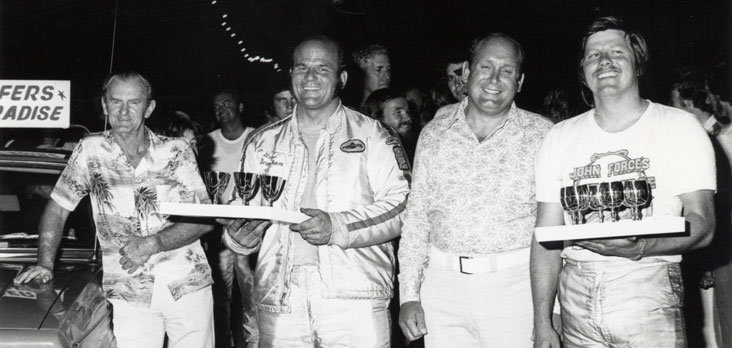
By now it’s part of the legend, how Densham helped fledgling flopper driver John Force during a tour of Australia in 1974 and became lifelong friends.
Everyone has heard the story, right? But it’s worth another telling, right? Right.
“The Aussies started running DragFest in 1969; they brought down [motorcycle racer] C.J. Potter, Larry Fullerton’s Trojan Horse [Funny Car], the Bushmaster [George Schreiber] dragster, and Bill Shrewsberry [and his wheelstander] -- a sample of what U.S drag racing was all about," Densham recalled. "A couple of years later they got Gene Beaver and the L.A. Hooker and Henry Harrison’s Vulture. Even though the cars didn’t perform very well, the fans still loved them. The next year, 1974, they contracted ‘Jungle Jim’ [Liberman] and Ed McCulloch –- you couldn’t ask for two better cars. Three months before they were supposed to go ‘Jungle’ backed out. They asked Beaver again; he said no, but because he was in the process of selling his car to Force, he said Force could go in his place.
“At the last minute, McCulloch also had to pull out. I was pretty close to Shrewsberry because I used to work on his car for him -- he wasn’t very mechanical -– because he had been a real mentor to me. He was the guy who told me which promoters to call, where to get a room, or even how to get to the racetrack –- we didn’t have Google Maps back then -– so it was a two-way street for us.

“Shrewsberry asked me to go, and, by pure luck, my car was completely together, cleaned up, rechromed, re-anodized and everything after having run the World Finals and sitting in the Long Beach car show.
“The first time I met John was in the [airport] concourse. He’s got a cowboy and a big leather jacket with sponsors all over it and I thought, ‘Boy, are we going to get our asses kicked.’ Back then there were so many cars you didn’t know everyone like you do today.
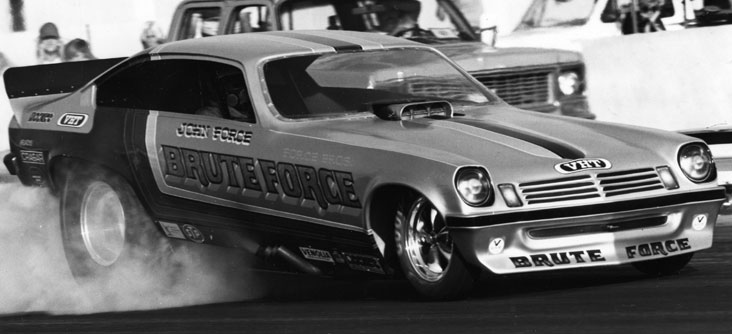
“Each of us had gotten three airplane tickets. John brought 'Shooter Doug’ [Robinson] to be his crew chief, but sold the other ticket to one of his school buddies who barely knew how to operate a rag. Doug was a nice guy but didn’t know how to put the camshaft in. I ended up doing it all for them. I had to work on his car and fix it every time he blew it up. I felt we were there to put on a show. My car was running really well and doing what it needed to do, but his wasn’t."
Force’s version is equally disastrous, but the hero wins in the end.

“I started the car in the parking lot in front of the TV station for the media and kicked a rod out the side," he related in an interview a few years ago. "That was one motor gone! Then in the first round I couldn’t get reverse gear after the burnout. My next transgression happened in the second round when the car made a right turn and almost hit the wall. But on the last run I ran over 210 mph, the quickest run in Australian history! I was running a high-gear car when everybody else had two-speeds, which were new at that time and as a result they had difficulty in getting down the race track.
“At the end of the night the track promoter, Dave Harding, told me, ‘You’re terrible, you’re fired and I don’t know why I even hired you!’ But next morning the newspaper headlines blasted “American makes fastest run ever!” So, Harding came back and said ‘OK, I’m stuck with you now because you’re a headliner.’ So he hired Sid Waterman to build me two motors, which I ran for the rest of the six-week tour. That’s how I got my break. Nobody knew me in the U.S., but when I returned home I quit my truck-driving job, put a new body on the race car and became a professional racer.”
Densham followed with other tours “down under” in 1978, 1979, 1982, and 1986 and was undefeated against American and Australian racers. In 1995, he even won the Australian National Championship.
FINAL THOUGHTS

“I would not change the amount of fun I’ve had or the people I’ve met for John Force’s 16 championships; I wouldn’t even consider it. You come out every race with the attitude that you’d like to win the race, but know that you’ll be satisfied if you can race the big guys, beat them now and then and give them a bloody nose -- that’s a win. You have to be realistic about your expectations. Although today there’s good money to make even if you qualify 17-20, I’ll quit before that’s my goal.
“I want a good e.t. slip and I want to hold the trophy. I want the car to run good. That’s always been the goal.”
Be sure to check out the new edition of National Dragster to read the whole story.
Phil Burgess can reached at pburgess@nhra.com



















































